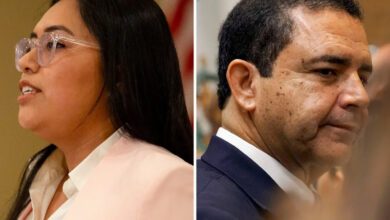A Look At How House, Senate Budgets Compare
Proposed 2016-17 Budgets
The Senate budget spends $211.4 billion, compared with the $209.8 billion budget in the House.
|
House version |
Senate version |
Current budget |
|
|
Public Ed |
$57.50B |
$59.00B |
$55.40B |
|
Higher Ed |
$19.60B |
$19.80B |
$18.50B |
|
Health & Human Services |
$79.10B |
$77.40B |
$74.50B |
|
*DPS/Criminal Justice |
$11.90B |
$12.00B |
$11.80B |
|
Transportation |
$24.80B |
$24.50B |
$23.20B |
General Revenue Spending in Proposed Budgets
General revenue, the portion of state funds that lawmakers have the most control over, makes up half of both budget proposals. The Senate budget spends $107.4 billion in general revenue, compared with $104.6 billion in the House.
|
House version |
Senate version |
Current budget |
|
|
Public Ed |
$37.70B |
$41.60B |
$37.40B |
|
Higher Ed |
$14.30B |
$14.50B |
$13.30B |
|
Health & Human Services |
$33.10B |
$32.70B |
$29.80B |
|
*DPS/Criminal Justice |
$11.00B |
$11.10B |
$9.20B |
|
Transportation |
$2.20B |
$0.80B |
$0.30B |
*The Department of Public Safety (DPS), the Alcoholic Beverage Commission, the Commission on Fire Protection and the Military Department are among the agencies in this category.
Public Education
Both chambers support increasing existing funding for public education in the state, but they disagree on how much. These figures represent general revenue spending.
HOUSE
$37.7 billion
The House budget puts $2.2 billion on top of what would be needed to fund enrollment growth in public schools, plus an additional $800 million if school finance reform legislation passes.
SENATE
$41.6 billion
The Senate budget appears to have more funding for public schools, but $4.5 billion of it would go to protect school districts against losing money if the Senate’s property tax proposal passes. It adds $1.5 billion on top of what would be needed to fund enrollment growth in public schools.
Read more on this issue: Budget fallout from school finance lawsuit
Higher Education
Both chambers are increasing funding overall for higher education by more than 5 percent, though the Senate 2016-17 budget’s increase is slightly higher. In both chambers, most of the increase comes from general appropriations.
HOUSE
$19.6 billion
The House plan adds $67.5 million from the Emerging Technology Fund to the Texas Research Incentive Program run by the Higher Education Coordinating Board, and it transfers $11 million to the Governor’s University Research Initiative, which would be used to attract top researchers to public universities.
SENATE
$19.8 billion
The Senate budget cuts funding by $8.9 million for the Texas Research Incentive Program. It adds $46 million to the Governor’s University Research Initiative.
Read more on this issue: Governor’s University Research Initiative
Medicaid
The House and Senate have proposed relatively similar dollar amounts but markedly different priorities for funding the state’s Medicaid program, which provides health insurance to the state’s poor and disabled. The House budget would pay primary care doctors more money for seeing Medicaid patients, while the Senate budget includes funding to pay for health care inflation and expects savings from “cost-containment initiatives.”
HOUSE
$62.9 billion
The House budget would boost Medicaid payments to primary care doctors to make them equal to the payments made to doctors under Medicare, the federal health insurance program for the elderly. That would cost about $1 billion in state and federal money. The House budget does not include money to pay for the cost of inflation, meaning those costs would likely have to be shouldered at a later date.
SENATE
$62.1 billion
The Senate budget would not change Medicaid payments to primary care doctors, leaving those reimbursement rates at about 65 percent of what Medicare pays. But it allocates $1.6 billion in federal and state money for inflation, and it predicts about $870 million in savings from “cost-containment initiatives.”
Read more on this issue: Addressing a physician shortage
Transportation Funding
Both chambers support boosting the Texas Department of Transportation’s 2016-17 funding, including giving the agency $1.3 billion in gas tax revenue that currently goes to other agencies. They disagree on where additional funding should come from.
HOUSE
$24.8 billion
The House budget would put $1.5 billion in extra funds toward TxDOT’s budget from general revenue funds for “non-tolled roadway projects.”
SENATE
$24.5 billion
The Senate budget would make a one-time allocation of $1.2 billion in motor vehicle sales tax revenue to the state highway fund. The Senate also favors permanently dedicating some future motor vehicle sales tax revenue to the state highway fund.
Read more on this issue: Dedicating car sales taxes to the highway fund
Tax Cuts
The Senate wants to cut property taxes, while the House prefers a cut in the sales tax rate. Both chambers agree on cutting business franchise taxes but differ on how to do it.
HOUSE
$4.9 billion
The House has proposed cutting the state sales tax rate from 6.25 percent to 5.95 percent, reducing state revenue by $2.3 billion. The lower chamber has also proposed more than $2 billion in cuts to the franchise tax, including a 25 percent across-the-board rate cut.
SENATE
$4.4 billion
The Senate wants to spend more than $2 billion to cover the costs of a local property tax cut, as well as cutting the franchise tax by 15 percent and exempting businesses that make less than $4 million annually from the franchise tax altogether.
Read more on this issue: Cutting margins taxes
Border Security
The state’s GOP leadership has named border security a high priority this session, largely because of the influx of undocumented immigrants from Central America who came to the Rio Grande Valley last summer. But the two chambers are about $300 million apart.
HOUSE
$565.2 million
The House budget dedicates $551 million to the Department of Public Safety for border security operations. That includes $105 million for 300 more troopers on the border, which was offset by reducing allotments for the Texas Military Department and the Texas Parks and Wildlife Department. Funds for the effort are also allocated to the Trusteed Programs Within the Office of the Governor, Texas Parks and Wildlife and the Department of Criminal Justice.
SENATE
$850.6 million
The Senate budget earmarks $811 million in general revenue funds for border security, $753 million of which is dedicated to the Department of Public Safety. Other agencies receiving funding for the effort are the Trusteed Programs Within the Office of the Governor and the Texas Parks and Wildlife Department.
Read more on this issue: Border security spending and operations
Emerging Technology Fund
The governor’s office has called for abolishing this incentive program and splitting its $95 million in funding between the Texas Enterprise Fund and a second new fund, the University Research Initiative, for the governor to use to draw notable academics to public universities. Neither chamber follows that request exactly.
HOUSE
$0
The House budget would transfer $67.5 million of the fund’s budget to the Higher Education Coordinating Board’s Texas Research Incentive Program and $22.5 million to a separate Texas Research University Fund specifically for the University of Texas at Austin and Texas A&M University. The remaining $11 million would go to the new university research fund controlled by Abbott.
SENATE
$0
The Senate budget would transfer half of the Emerging Technology Fund’s budget, $46 million, to the Texas Enterprise Fund, and transfer the other half to the Higher Education Coordinating Board to provide matching funds to Texas public universities to recruit Nobel Laureates and National Academy members to Texas.
Texas Racing Commission
The Senate hasn’t backed down from its threat to defund the Texas Racing Commission.
HOUSE
$16.7 million
The House budget would increase funding for the commission by $1.3 million.
SENATE
$0
The Senate budget sets aside no money for the commission, which senators have called a “rogue” and “renegade” agency.
Read more on this issue: Defunding the Racing Commission
Correctional Officer Pay
The Department of Criminal Justice has requested a 10 percent pay raise for thousands of correctional and parole officers to address retention issues. Only the House fully complied with the request.
HOUSE
$276.5 million
The House budget includes $235 million to cover a 10 percent pay raise for correctional and parole officers and $41.5 million for pension benefits and Social Security contributions.
SENATE
$102.8 million
The Senate budget includes $88.9 million to provide 2.5 percent pay raises in the 2016 and 2017 fiscal years and $13.9 million for pension benefits and Social Security contributions.
Film Incentives
Both plans contain less funding for film incentives than the current budget, but the Senate version slashes film incentives funding drastically. Gov. Greg Abbott’s office has called for designating at least $70 million — and ideally $95 million — for film incentives.
HOUSE
$73.7 million
Funding in the House budget for film and music marketing just exceeds the minimum amount requested by the governor’s office. Some of that funding is contingent on the comptroller certifying that the program is worth the cost. The money is primarily used for incentives for film and video game companies that hire Texas workers to produce projects in the state.
SENATE
$10 million
The Senate budget slashes film incentives funding for the next biennium by $85 million, down from the $95 million in the 2014-15 budget.
Read more on this issue: Cutting incentives programs
Sex Offender Housing
The Office of Violent Sex Offender Management, responsible for supervising and treating sexually violent predators, doesn’t have space to house sex offenders being released from prison, and the program will take in 100 new sex offenders in the next two years at an increased cost. The office has asked lawmakers for $11.4 million in additional funds in the 2016-17 budget.
HOUSE
$24.4 million
The House budget would provide the full $11.4 million increase.
SENATE
$20.4 million
The Senate budget would provide a $7.5 million increase in funds — around $4 million short what the office requested.
Read more on this issue: Housing for sex offenders
Mental Health
Both chambers support boosting funding for behavioral health and substance abuse services. Their plans differ on the amount of increased funding and whether NorthSTAR — a Medicaid service unit for mental health and chemical dependency services — should continue to receive state money.
HOUSE
$3.8 billion
The House budget includes $2.9 billion to be distributed across 18 agencies — including NorthStar — for an overall increase of $304.3 million.
SENATE
$3.7 billion
Aman Batheja and Becca Aaronson are reporters for the Texas Tribune where this story originally published and reprinted here through a news partnership between the Texas Tribune and Corridor News.






